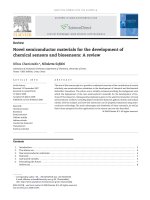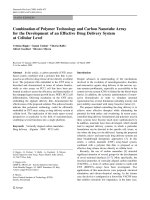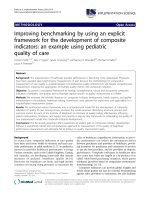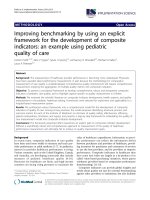biological model of fetomaternal haemorrhage for the development of first trimester non invasive prenatal diagnosis
Bạn đang xem bản rút gọn của tài liệu. Xem và tải ngay bản đầy đủ của tài liệu tại đây (1.78 MB, 236 trang )
A BIOLOGICAL MODEL OF FETOMATERNAL
HAEMORRHAGE FOR THE DEVELOPMENT OF FIRST-
TRIMESTER NON-INVASIVE PRENATAL DIAGNOSIS
NURUDDIN MOHAMMED
(M.B.B.S Aga Khan University; MSc (Clinical Sciences) NUS)
A THESIS SUBMITTED
FOR THE DEGREE OF DOCTOR OF PHILOSOPHY
DEPARTMENT OF OBSTETRICS AND GYNAECOLOGY
NATIONAL UNIVERSITY OF SINGAPORE
2005
i
ACKNOWLEDGEMENTS
The work presented in this thesis describes research undertaken by me at Rare Event
Detection Laboratory, Department of Obstetrics and Gynaecology, National University of
Singapore. Through out this time, I was supported by research scholarship from National
University of Singapore, while National Medical Research Council, Singapore, funded
my consumables.
Firstly, I would like to thank my supervisors Associate Professor Arijit Biswas and Chan
Woon Khiong for their guidance and support. I am indebted to the Chairman, Thesis
Advisory Committee, Assistant Professor Mahesh Choolani for his excellent guidance
and support during this period. I am very grateful to the Post-Doctoral Fellow Dr.
Sukumar Ponnusamy who stood by me during this time and provided me with his
invaluable advice.
It has been a great pleasure working in the Rare Event Detection Group with Dr.
Narasimhan, Ho Sze Ye, Houming, Chang Xing, Dr. Qin Yan and Weiyong. I am
grateful to Dr. Chan Yiong Huak for his statistical assistance. I would like to thank our
patients, as without their contribution this research would not have taken place. My
special thanks to Associate Professor Bay Boon Huat for providing me social support. I
am thankful to the Professor Emeritus Late Sir Shan Ratnam, Professor Ariff Bongso and
Dr. Anandakumar Chinnaiya for encouraging me to pursue my doctorate.
Finally, I want to thank my parents, whose prayers were with me all the time; Rozina for
her unended support; Aine NurAizza and Aly Khan for cheering me up at times of
despair; and Nafeesa, Khadija, Nizam, Gulnaz and Karim for their moral support.
ii
TABLE OF CONTENTS
ACKNOWLEDGEMENTS i
TABLE OF CONTENTS ii
SUMMARY x
LIST OF TABLES xvi
LIST OF FIGURES xviii
LIST OF ABBREVIATIONS xxiv
CHAPTER 1: INTRODUCTION 1
1.1 Overview 1
1.2 Current methods of prenatal diagnosis 4
1.3 Screening for chromosomal disorders 5
1.4 Screening for genetic disorders 12
1.5 Diagnosis of chromosomal and genetic disorders 12
1.5.1 Invasive procedures for diagnosis of chromosomal and genetic disorders 13
1.5.2 Laboratory analysis of fetal material after invasive testing 18
1.6 Developments on non-invasive prenatal diagnosis of chromosomal
and single gene disorders 20
1.6.1 Cell-free fetal DNA in maternal plasma 21
iii
1.6.2 Transcervical sampling of fetal cells 24
1.6.3 Fetal cells in maternal blood 26
1.6.3.1 Candidate target cells for non-invasive prenatal diagnosis 26
1.6.4 Non-invasive prenatal diagnosis using fetal nucleated erythroblasts in
maternal blood 38
1.6.4.1 Identification of fetal origin of erythroblasts enriched from maternal
blood 39
1.6.4.2 Diagnosis of chromosomal and monogenic disorders using fetal
nucleated erythroblasts enriched from maternal blood 43
1.6.4.3 Various approaches for the enrichment of fetal nucleated erythroblasts
from maternal blood 49
1.6.4.4 Testing enrichment protocols in maternal blood 60
1.7 Experimental aims and hypotheses 66
1.7.1 Hypotheses 72
CHAPTER 2: MATERIALS AND METHODS 73
2.1 Materials 73
2.1.1 Human tissue and blood samples 73
2.1.1.1 Ethical approval for use of human tissue and blood samples 73
iv
2.1.1.2 First trimester trophoblasts, second trimester fetal blood samples
and cord blood 73
2.1.1.3 Peripheral blood from pregnant women 74
2.1.1.4 Peripheral blood from healthy male volunteers 74
2.1.2 Antibodies, reagents, media, solutions and kits 74
2.1.2.1 Antibodies 74
2.1.2.2 Reagents and supplements 74
2.1.2.3 Solutions 75
2.1.2.4 Kits 75
2.1.3 Hardware 76
2.1.3.1 Pipettes, centrifuge tubes, slide storage box and filters 76
2.1.3.2 Immunomagnetic cell sorting equipment 76
2.1.3.3 Centrifuges for polypropylene tubes 76
2.1.3.4 Cytocentrifuge and water bath 77
2.1.3.5 Chromosomal fluorescence in-situ hybridisation block 77
2.1.3.6 Blood collection tubes, slides, coverslips, haemocytometer, coplin
jars, immersion oil and Parafilm
TM
77
2.1.3.7 Microscopes and filters 77
v
2.1.3.8 Computers and software 78
2.2 Methods 79
2.2.1 Nucleated cell count 79
2.2.2 Cytospin preparation 79
2.2.3 Preparation of fetal trophoblast cells and primitive fetal erythroblasts
from products of conception 79
2.2.4 Preparation of adult mononuclear cells using Ficoll 1077 for external
negative controls 80
2.2.5 Wright’s stain 81
2.2.6 Preparation of Percoll gradients 82
2.2.7 Layering the cells 83
2.2.8 Centrifugation 84
2.2.9 Selective lysis of mature anucleate red blood cells 85
2.2.10 Immunocytochemistry 86
2.2.11 Magnetically-activated cell sorting (MACS) 87
2.2.12 Standard XY cFISH 88
2.2.13 Simultaneous immunofluorescence cytochemistry and cFISH 89
2.2.14 Combined immunocytochemistry – Vector Blue Substrate, immuno-
vi
-fluorescence AMCA and cFISH 90
2.2.15 Quantitative analysis of cell-free fetal DNA 91
2.2.16 Enrichment of epsilon-globin positive primitive fetal nucleated
erythroblasts from trisomy 18 syndrome fetus beyond first-trimester
and from neonates at term 93
2.2.17 Effect of ammonium chloride lysis buffer on first-trimester primitive fetal
nucleated erythroblasts and on adult anucleate erythrocytes 94
2.2.18 Effect of ammonium chloride alone and ammonium chloride/1mM
acetazolamide on a model mixture of primitive fetal nucleated
erythroblasts and adult anucleated red blood cells 95
2.2.19 Optimisation of second-step enrichment method on maternal
blood samples 96
2.2.20 Examination of the efficiency of a novel three-step enrichment protocol for
first-trimester non-invasive prenatal diagnosis in in-vitro model system 96
CHAPTER 3: Presence of ε-globin primitive fetal nucleated
erythroblasts beyond the first-trimester and at birth in trisomy
18 syndrome neonates: Implication for non-invasive prenatal
diagnosis 98
3.1 Introduction 98
3.2 Enrichment of epsilon-globin positive primitive fetal nucleated erythroblasts
vii
from trisomy 18 syndrome fetus beyond first-trimester and from neonates
at term (section 2.2.16) 99
3.3 Conclusion 106
CHAPTER 4: Termination of pregnancy as an in-vitro model
system to study first-trimester non-invasive prenatal diagnosis 108
4.1 Introduction 108
4.2 Effect of ammonium chloride lysis buffer on first-trimester primitive fetal
nucleated erythroblasts and on adult anucleate erythrocytes (section 2.2.17) 109
4.3 Effect of ammonium chloride alone and ammonium chloride/1mM
acetazolamide on a model mixture of primitive fetal nucleated erythroblasts
and adult anucleated red blood cells (section 2.2.18) 112
4.4 Optimisation of second-step enrichment method on maternal blood
samples (section 2.2.19) 115
4.5 Development of combined immunocytochemical, immunoflourescence
staining of ε-globin and cFISH for first-trimester non-invasive prenatal
diagnosis 119
4.6 Examination of the efficiency of a novel three-step enrichment protocol for
first-trimester non-invasive prenatal diagnosis in in-vitro model system
(2.2.20) 124
viii
4.7 Conclusion 129
Chapter 5: Termination of pregnancy as an in-vivo model
to study enrichment efficiency of a novel non-invasive
prenatal diagnosis method in the first-trimester using
cell-based strategy 131
5.1 Introduction 131
5.2 Enrichment of primitive fetal nucleated erythroblasts from
first-trimester maternal blood before and after termination of
pregnancy 133
5.3 Conclusion 142
CHAPTER 6: Termination of pregnancy as a model system to
study first-trimester non-invasive prenatal diagnosis using
cell-free fetal DNA 145
6.1 Introduction 145
6.2 Effect of first-trimester termination of pregnancy on cell-free fetal
DNA levels in maternal blood 146
6.3 Conclusion 151
ix
CHAPTER 7: General Discussion 153
7.1 Hypotheses 153
7.2 Implication of results in the context of non-invasive prenatal diagnosis 155
7.3 Using epsilon-globin positive primitive fetal nucleated erythroblasts for
diagnosis of genetic disorders at single cell level 157
7.4 Limitations of this research 160
7.5 Directions for future research 161
REFERENCES 163
APPENDIX: PUBLICATIONS 210
x
SUMMARY
Background
Non-invasive methods for obtaining intact fetal cells would permit accurate prenatal
diagnosis for aneuploidy and single gene disorders without attendant risks associated
with invasive procedures. In chromosomally abnormal fetus such as trisomy 18,
existence of fetal primitive nucleated erythroblasts during second trimester and at birth
has not yet been identified. If proven, it could be of great clinical significance, as the
existence of these cells could indicate not only the presence of a chromosomally
abnormal fetus but also imply that the ε-globin primitive fetal nucleated erythroblasts are
also ideal cell to be targeted in the second trimester for non-invasive prenatal diagnosis.
Various fetal cell enrichment protocols are available; their efficiency has not been tested
appropriately in an in-vitro model system and it is important to evaluate the intrinsic
protocol efficiency in-vitro before studying its enrichment efficiency in an in-vivo model.
To date, there is no biological model to determine the in-vivo efficiency of any new fetal
cell enrichment protocol.
Cell-free fetal DNA has been investigated as a marker for feto-maternal haemorrhage at
surgical termination of pregnancy and we planned to use this fetal genetic material as
corroborating evidence of the quantity of feto-maternal haemorrhage.
Study Objectives
(i) To evaluate the presence of ε-globin-positive primitive fetal nucleated erythroblasts in
trisomy 18 syndrome fetus during second trimester and at birth.
xi
Trisomy 18 was selected as a model to prove this hypothesis. The choice of T18 as an
aueploid model to base our investigations was based upon the assumption that the
haemoglobin switch is similar in all aneuploidies, and that the placental interface is
similar in its leakiness for both T18 and T21. We acknowledge that T18 is rarer than T21
and choosing T18 will limit our ability to gauge what happens in a T21 pregnancy which
is more clinically relevant, it was due to the availability of T18 cases in our unit at that
point in time and lack of any T21 cases, that we chose to undertake T18 to prove our
hypothesis.
(ii) To evaluate efficiency of a new fetal cell enrichment protocol in in-vitro model
system.
(iii) To develop an in-vivo model of biological feto-maternal haemorrhage that could be
used to evaluate efficiency of new fetal cell enrichment protocol for non-invasive
prenatal diagnosis in the first trimester.
Hypotheses
1. Embryonic epsilon-globin positive nucleated red blood cells persists beyond the
second trimester using T18 as a model.
2a. Surgical termination of pregnancy can be used to evaluate efficiency of a new fetal
cell enrichment protocol in in-vitro model system.
2b. Surgical termination of pregnancy can be used as an in-vivo model to study
enrichment efficiency of a novel non-invasive prenatal diagnosis method in the first
trimester.
xii
Methods
To address the first hypothesis pure sample of fetal blood was obtained via cordocentesis
from a viable trisomy 18 fetus (n = 1) and karyotypically normal fetuses (n = 4) during
the second trimester. Cord blood samples were obtained from three trisomy 18 and
twenty karyotypically normal neonates at term vaginal birth delivery. The fetal blood
and cord blood samples were processed using Ficoll 1077 and Percoll 1083 density
gradient centrifugation, respectively followed by anti-GPA selection on MACS to obtain
glycophorin-A-(GPA)-positive fetal erythroblasts. Morphology of primitive fetal
nucleated erythroblasts was evaluated by Wright stain and presence of ε-globin within the
cytoplasm was determined using immunocytochemical staining.
To address hypothesis 2a, primitive fetal erythroblasts were isolated from products of
conception obtained in the first trimester after surgical termination of pregnancy and were
spiked into adult peripheral blood and processed through the three-step enrichment
method comprising of first step Percoll 1118 density gradient, second-step enrichment
method using anti-CD45/anti-GPA on MACS followed by treatment with ammonium
chloride/1mM acetazolamide cocktail lysis buffer. FNRBCs recovered were calculated
and identified by Wright’s staining and ε-globin immunocytochemistry and ICC-cFISH.
To address hypothesis 2b, two maternal blood samples were collected from each patient:
20 ml prior to surgical termination of pregnancy and another 20 ml within 5 minutes after
the surgical procedure (n = 10). They were processed immediately using our three-step
enrichment protocol. Cells enriched were cytospun for identification. Fetal gender was
confirmed by cFISH on FNRBCs and trophoblasts prepared from trophoblastic villi
obtained from same patients.
xiii
Cytospun slides were Wright’s stained for morphological identification of FNRBCs.
Slides containing NRBCs as identified by Wright’s staining were de-stained and
examined for the presence of fetal ε-globin positive primitive erythroblasts by
immunocytochemistry. The locations of these cells were recorded. Slides were then
destained in xylene, rinsed in distilled water, put through ICC-cFISH, to examine gender
of ε-globin cells.
Both total and cffDNA were quantified using real-time quantitative PCR. TaqMan
amplification reactions were set up in a reaction volume of 25 µl. Each reaction contained
1x Taqman Universal-Master-Mix, 240 nM of each amplification primer, 100 nM of the
corresponding TaqMan probe and 5 µl of the extracted plasma DNA. Thermal cycling for
both SRY and β-globin was initiated with 2-min incubation at 50˚C, which followed the
first denaturation step for 10 min at 95˚C and then 55 cycles of 95˚C for 15s and 60˚C for
1 min.
Results
Compared to normal controls, the proportion of fetal nucleated red blood cells was found
to be 16- and 14-fold higher in a second trimester trisomy 18 fetus (n = 1) and in trisomy
18 neonates at birth (n = 3), respectively. Epsilon-globin-positive primitive fetal
nucleated erythroblasts were found both during second trimester and at birth, indicating
continued gene expression of epsilon-chain in trisomy 18 aneuploidy.
The three-step enrichment protocol to be tested for its efficiency in in-vitro model
consisted of Percoll 1118 density-gradient-centrifugation (first-step), anti-CD45 or anti-
GPA alone or as anti-CD45/anti-GPA combination (second-step) and selective
erythrocyte lysis by combination of NH
4
Cl/acetazolamide buffer at the ratio of 1:2 (third-
xiv
step). Using anti-CD45/anti-GPA combination gave a pure population of red blood cells
compared to their use alone, making the former suitable as the second-step enrichment
method. Selective lysis during third step with the combination of NH
4
Cl/acetazolamide
buffer showed 96% of adult erythrocytes to be lysed and 93% of fetal nucleated red blood
cells intact. Thus, a three-step protocol was adopted to test its efficiency in in-vitro
model.
The efficiency of the three-step enrichment system in in-vitro model was 37% (95% CI,
28.5%-45.6%; n = 8). Enriched primitive fetal erythroblasts were accurately identifiable
by both ε-globin light microscopic immunocytochemistry and ICC-cFISH.
Using surgical termination of pregnancy as an in-vivo model, significantly more FNRBCs
and ε-globin positive primitive erythroblasts were recovered from post-termination of
pregnancy maternal blood samples (3 and 2.8-fold, respectively). A significant positive
correlation was also observed between gestational age and increase in FNRBCs (r=0.66;
p=0.03) and ε-globin positive cells (r=0.65; p=0.04).
Increase in FNRBCs in maternal blood after surgical termination of pregnancy was
associated with a concomitant increase in ε-globin positive fetal primitive erythroblasts
(correlation co-efficient, r=0.82; p=0.004).
In pregnancies with male fetuses (n=8), a significant increase in FNRBCs (3 fold) and ε-
globin positive primitive fetal erythroblasts (2.8 fold) was seen after the surgical
termination of pregnancy.
xv
There was no change in either the total DNA or the cell-free male fetal DNA levels in
maternal plasma after, compared with before, surgical termination of pregnancy.
Therefore, surgical post-termination of pregnancy enrichment of ε-globin positive
primitive fetal erythroblasts can estimate the efficiency of that particular enrichment
system in on-going pregnancies. It shows that an enrichment protocol can expect three-
fold fewer fetal cells in an ongoing first trimester pregnancy than the number of cells
enriched from first trimester maternal blood obtained after surgical termination of
pregnancy.
A mathematical relationship between the distribution of epsilon positive fetal
erythroblasts in pre- and post-termination maternal blood was derived as follows:
Observed number of pre-termination primitive FNRBCs = co-efficient between pre- and
post-termination primitive FNRBCs x observed number of post-termination primitive
FNRBCs. The co-efficient of our model is 0.35 (95%CI, 0.26-0.44) and the regression
coefficient, R
2
is 0.89.
Our observations suggest that an accurate in-vivo enrichment efficiency of any new
enrichment protocol could be developed using maternal blood obtained within 5 minutes
after first trimester surgical termination of pregnancy.
xvi
LIST OF TABLES
Table 1.1: Enrichment of fetal nucleated erythroblasts from maternal
blood 63
Table 1.2: Testing efficiency of enrichment protocols by using invasive
procedures as in-vivo model system 64
Table 4.1: Effect of ammonium chloride lysis buffer on fetal nucleated
erythroblasts across 5 to 40 minutes time interval (n = 4) 111
Table 4.2: Effect of ammonium chloride lysis buffer on adult anucleated red
blood cells across 5 to 40 minutes time interval (n = 4) 111
Table 4.3: Effect of ammonium chloride on cell lysis in a model mixture of
PFNRBCs and adult erythrocytes (n = 4) 113
Table 4.4: Effect of ammonium chloride/1mM acetazolamide on a model mixture
of PFNRBCs and adult erythrocytes (n = 4) 113
Table 5.1: Enrichment of NRBCs and ε-globin positive primitive fetal
erythroblasts after three-step protocol 136
Table 5.2: Enrichment of NRBCs and ε-globin positive primitive fetal
erythroblasts after three-step protocol 136
Table 6.1: Cell-free fetal DNA concentration before and after termination of
pregnancy in the first-trimester 148
xvii
Table 6.2: Fold-increase in NRBCs, ε-globin positive primitive fetal nucleated
erythroblasts and cell-free fetal DNA concentration after termination
of pregnancy in the first-trimester 149
xviii
LIST OF FIGURES
Figure 2.1: Two cell layers formed after density gradient centrifugation
with Percoll 1118 84
Figure 2.2: Immunocytochemistry on fetal primitive nucleated erythroblasts
enriched from products of conception 87
Figure 2.3:
Nuclear fast red stain on ε-globin positive primitive fetal nucleated
erythroblasts enriched from products of conception 87
Figure 2.4: Standard cFISH (A) and simultaneous AMCA and cFISH on fetal
primitive erythroblasts (B): XX fetus 90
Figure 3.1: Peripheral smear from fetal blood of karyotypically normal fetuses
(n = 4; GA = 21-23 weeks) and trisomy 18 fetus (n = 1; GA =
20 weeks) 100
Figure 3.2: Red blood cells sorted on MACS using positive selection with
Glycophorin A after first step density gradient centrifugation by Ficoll
1077 on fetal blood of normal fetuses (n = 4; GA = 21-23 weeks) and
trisomy 18 fetus (n = 1; GA = 20 weeks) 100
Figure 3.3: ε-globin staining (vector blue) of primitive fetal nucleated
erythroblasts by alkaline phosphatase immunocytochemistry in a T18
fetus after first step density gradient centrifugation using Ficoll 1077
followed by positive selection with Glycophorin A on MACS (GA =
xix
20 weeks) 101
Figure 3.4: Peripheral smear from cord blood of karyotypically normal (n = 20)
and trisomy 18 newborns (n = 3) at birth 102
Figure 3.5: Distribution of fetal nucleated red blood cells after first step density
gradient centrifugation using Ficoll 1077 on cord blood of
karyotypically normal (n = 20) and trisomy 18 newborns (n = 3) at
birth 103
Figure 3.6: Red blood cells sorted by MACS using positive selection with
Glycophorin A after first step density gradient centrifugation with Ficoll
1077 on cord blood of karyotypically normal (n = 20) and trisomy 18
newborns (n = 3) at birth 103
Figure 3.7: ε-globin staining (vector blue) of primitive fetal nucleated
erythroblasts by alkaline phosphatase immunocytochemistry after
positive selection with Glycophorin A following first step density
gradient centrifugation with Ficoll 1077 on cord blood of trisomy 18
newborns at birth (n = 3) 104
Figure 3.8: cFISH demonstrating three copies of chromosome 18 in fetal
nucleated red blood cells 104
Figure 4.1: Enrichment of primitive fetal nucleated erythroblasts from
trophoblast tissue for model mixture experiments 110
xx
Figure 4.2: Immunofluorescence staining and cFISH on primitive fetal
nucleated erythroblasts after selective erythrocyte lysis 114
Figure 4.3: Contamination with maternal polymorphonuclear leukocytes in
enriched fraction using anti-GPA or anti-CD45 alone on MACS
after first step Percoll 1118 density gradient centrifugation 117
Figure 4.4: Pure population of red blood cells in enriched fraction after first step
density gradient centrifugation using Percoll 1118 followed by anti-
CD45 then anti-GPA on MACS and selective erythrocyte
lysis 118
Figure 4.5: Combined immunocytochemical, immunofluorescence
staining and cFISH on primitive fetal nucleated erythroblasts
enriched from maternal blood: XY fetus 121
Figure 4.6: Combined immunocytochemical, immunofluorescence
staining and cFISH on primitive fetal nucleated erythroblasts
enriched from maternal blood: XX fetus 122
Figure 4.7a: cFISH on fetal trophoblasts cells enriched from products of
conception: Immunofluorescence staining of nucleus with DAPI
(Blue colour). Red signal shows XX chromosome:
Female fetus 123
Figure 4.7b: cFISH on fetal trophoblasts cells enriched from products of
conception: Immunofluorescence staining of nucleus with DAPI
xxi
(Blue colour). Red signal shows X chromosome and green signal
shows Y chromosome: Male fetus 123
Figure 4.8: Loss of fetal nucleated red blood cells in supernatant after first step
Percoll 1118 density gradient centrifugation 125
Figure 4.9: Enrichment of fetal nucleated red blood cells after three-step
method in in-vitro model system 126
Figure 4.10: Immunofluorescence staining and cFISH on primitive fetal
nucleated erythroblasts after three-step enrichment method
in in-vitro model system 126
Figure 4.11: cFISH on fetal trophoblasts cells enriched from products of
conception: Immunofluorescence staining of nucleus with DAPI
(Blue colour). Red signal shows XX chromosome:
Female fetus 127
Figure 4.12: Loss of fetal primitive erythroblast in Percoll 1118 cushion
after the first step density gradient centrifugation 127
Figure 4.13: Loss of fetal primitive erythroblasts within LD column
during the second-step enrichment process on MACS 128
Figure 4.14: Loss of fetal primitive erythroblasts in negative fraction
of MS column during the second-step enrichment process on
MACS 128
xxii
Figure 5.1: Correlation between fold increase in nucleated red blood cells
and ε-globin positive primitive fetal nucleated erythroblasts after
termination of pregnancy 137
Figure 5.2: Correlation between pre-termination enriched NRBCs and
gestational age 137
Figure 5.3: Correlation between pre-termination enriched ε-globin positive
primitive fetal nucleated erythroblasts and gestational age 138
Figure 5.4: Immunofluorescence staining and cFISH on male fetal primitive
nucleated eryhthroblasts enriched from first-trimester maternal
blood 139
Figure 5.5: Immunofluorescence staining and cFISH on female fetal primitive
nucleated erythroblasts enriched from first-trimester maternal
blood 139
Figure 6.1: Amplification curve of SRY on cell-free fetal DNA from
maternal plasma 147
Figure 6.2: Correlation between fold increase in NRBCs and ε-globin
positive primitive fetal nucleated erythroblasts after termination
of pregnancy (Male fetuses) 149
Figure 6.3: Lack of correlation between numbers of post-termination
xxiii
enriched NRBCs and cell-free fetal DNA concentration 150
Figure 6.4: Negative correlation between numbers of post-termination
enriched ε-globin positive primitive fetal nucleated erythroblasts
and cell-free fetal DNA concentration 151
Figure 7.1: Application of micromanipulation technique on first-trimester
primitive fetal nucleated erythroblasts enriched from products
of conception 159
Figure 7.2: Immunofluorescence staining of ε-globin and cFISH for gender
identification on primitive fetal nucleated erythroblasts after
micromanipulation 160
xxiv
LIST OF ABBREVIATIONS
DNA Deoxy-ribonucleic acid
cFISH Chromosomal fluorescence in-situ hybridisation
AFP α-feto protein
AMCA 7-amino-4-methylcoumarin-3-acetic acid
β-hCG β-subunit of human chorionic gonadotropin
BFU-e Burst forming units-erythroid
BSA Bovine serum albumin
CA carbonic anhydrase
CCD Cooled coupled device
CFU-e Colony forming units-erythroid
CGH Comparative Genomic Hybridisation
CRL Crown-rump length
CVS Chorionic villus sampling
DAPI Diamidino-2-phenyl-indole
DMD Duchenne Muscular Dystrophy
EDTA Ethylene-diamine tetraacetic acid
FACS Fluorescence-activated cell sorting
FISH fluorescence in-situ hybridisation
FITC Fluorescein isothiocyanate
FNRBC Fetal nucleated red blood cell
g Centrifugal g force or grams
GPA Glycphorin A
Hb Haemoglobin
HbF Haemoglobin F; Fetal haemoglobin









